Fear-mongering or Fact: Seafood Edition
Parasites, Microplastics, Mercury Poisoning, Oh My! All of your questions about seafood answered with ~nuance~ 😉
I’ve been wanting to write this post for a while. As someone who shares nutrition-focused content online, I’m (unfortunately) all too familiar with the viral food and nutrition trends circulating. Lately, I’ve noticed a growing confusion and fear around seafood. Every time I post a meal with seafood, my DMs light up with comments about how I shouldn’t eat fish because of parasites, microplastics, and mercury poisoning.
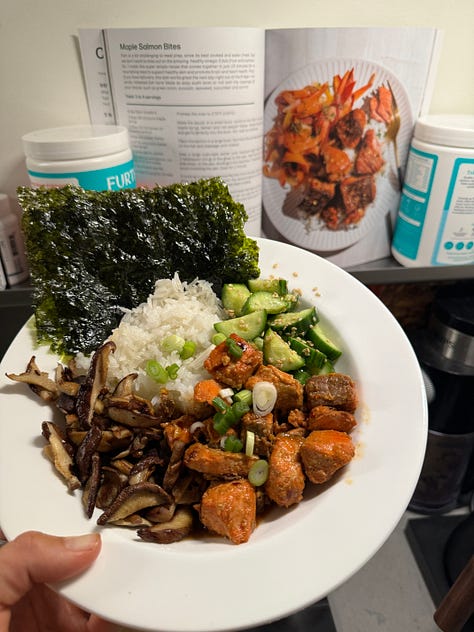
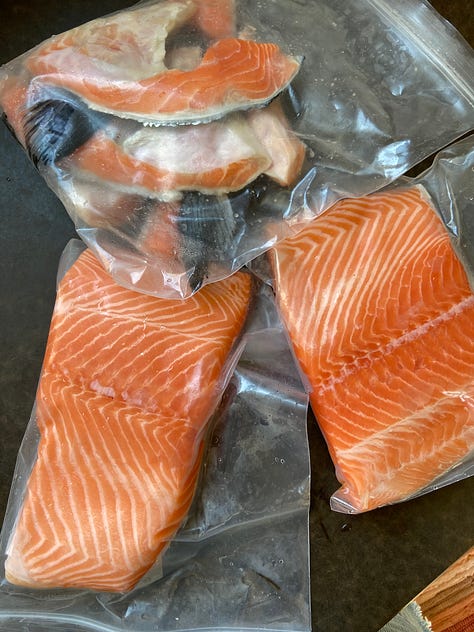

While some of these concerns are valid, I worry that many of the voices spreading this fear—often from shirtless dudes telling you what you should or shouldn’t eat—are leaving out a lot of important context and nuance. It’s concerning to me that someone might watch a 20-second video on seafood with little to no context and then decide to eliminate such a nutritious food from their diet, possibly leading to nutrient deficiencies and poor health outcomes in the long run.
So today, I want to start a more nuanced conversation about seafood, and answer some of your most common questions, including:
Wild-caught vs. farm-raised: What’s the difference?
Sustainability concerns: Should we be worried?
Parasites in seafood: How concerned should we be?
Affordable seafood recipe ideas: How to enjoy seafood without breaking the bank.
Stick around until the end for the full Q&A based on your questions from Instagram!
Farmed vs. Wild-Caught Fish: What’s the Difference?
When choosing seafood, one of the key decisions is understanding whether the fish was wild-caught or farmed. Both have their merits and challenges.
Wild-Caught Fish
These are fish caught directly from their natural environment (oceans, rivers, lakes). They’re often praised for their natural diet and lower risk of disease but come with concerns like overfishing and environmental disruption.
Farmed Fish
Farmed fish are raised in controlled aquaculture systems. There are legitimate concerns related to type of feed, waste, disease transfer, and the use of antibiotics, but when done well, farmed fish can reduce pressure on wild populations, provide a stable supply chain, and limit the environmental toll of commercial fishing.
Common Misconception…
There is a common misconception that ALL farmed fish is horrible from a health perspective and that you should never eat farmed fish. While that may have been true for many years, and most fish farming practices are not ideal from an environmental and health perspective, you actually can find high quality farmed fish from brands that are doing things the right way.
Just like with cows and other ruminant animal proteins, farmed fish can actually be beneficial to the environment if managed well. There is such thing as regenerative aquaculture! From a sustainability perspective, farmed fish can reduce the strain on wild fisheries and can help meet the growing demand for seafood without depleting oceans. From a health point-of-view, you can actually better control the contaminants and toxins that impact seafood, like mercury and microplastics. The key to reaping the benefits of farmed fish lies in sustainable aquaculture practices, which prioritize environmental stewardship, disease management, and responsible feed sources.
TL;DR - Would I buy farmed fish from the supermarket or order farmed fish at a restaurant before confirming their sourcing? No, that would not be my first choice. In that case I would opt for wild caught or choose a different protein. But, I would like to dispel this myth that ALL farmed fish is horrible. In fact, I happily shop from brands like Seatopia that are practicing regenerative aquaculture which not only produces super high quality food, but also goes beyond sustainability to actively regenerate and improve marine ecosystems.
Seatopia sources their seafood from farms that use feeds derived from sustainable sources, like algae and insect protein, and integrate fish farming into broader marine ecosystems, mimicking natural processes and promoting biodiversity. This way they are producing quality seafood that is free of contaminants like mercury and microplastics and minimizing the negative impacts on the environment. In fact, if mercury or microplastics are a concern of yours when it comes to seafood consumption, a quality farmed fish might be the way to go. Seatopia’s seafood is lab-tested mercury-safe and zero microplastics.
Mercury in Seafood: Should We Be Concerned?
When it comes to eating seafood, one concern that often comes up is mercury—specifically, the risk of mercury contamination in fish and shellfish. Mercury is a naturally occurring heavy metal that can be harmful to human health, especially when consumed in high amounts over time. But how real is the risk from seafood? And is mercury something we should actually worry about?
How Does Mercury End Up in Seafood?
Mercury enters our waterways primarily through industrial pollution. Once in the water, mercury gets converted into methylmercury, a highly toxic form that bioaccumulates in the food chain. This means that smaller fish absorb methylmercury from their environment, and when larger fish eat them, the mercury builds up in their bodies over time.
Which Fish Have the Highest Mercury Levels?
Certain fish and seafood species are known to accumulate more mercury than others. These tend to be larger, longer-living fish. Here are some examples of fish that typically contain higher levels of mercury:
Shark
Swordfish
King Mackerel
Tilefish
Bigeye Tuna
Which Fish Are Safer Choices?
If you are looking for seafood options that are naturally lower in mercury, look for:
Salmon
Sardines
Mackerel (Atlantic mackerel, not king mackerel)
Anchovies
Pollock
Tilapia
Cod
Shrimp
These fish tend to be lower on the food chain, accumulate less mercury, and are still excellent sources of omega-3 fatty acids, protein, and other nutrients.


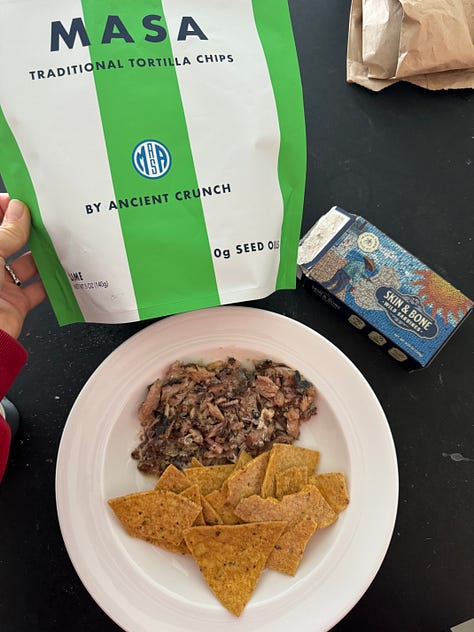
Is Mercury in Seafood Really a Health Concern?
For most people, moderate seafood consumption is unlikely to pose a significant health risk from mercury. The health benefits of eating fish—such as improved heart health, brain function, and the anti-inflammatory properties of omega-3s—often outweigh the risks, especially if you choose lower-mercury fish.
Not only is seafood one of the best sources of brain-supporting Omega-3 fats like DHA and EPA, they are also an incredible source of many essential nutrients:
The concern is that mercury toxicity can affect the nervous system, especially in young children, fetuses, and people who consume large amounts of high-mercury fish over time. However, there are some really interesting studies that push back against the heavy restrictions of seafood during pregnancy. One found that “consumption of a wide range of amounts and types of commercially available seafood during pregnancy is associated with improved neurocognitive development of offspring as compared to eating no seafood. Overall, benefits to neurocognitive development began at the lowest amounts of seafood consumed (∼4 oz/wk) and continued through the highest amounts, above 12 oz/wk, some range up to >100 oz/wk.” Another study even found a positive association between the level of mercury exposure in utero and cognitive abilities. I highly recommend this article (and others by Lily Nichols) to learn more about this topic.
Bottom Line
While mercury in seafood is a legitimate concern, the health benefits of eating fish—especially lower-mercury options—usually outweigh the risks for most people. By balancing your seafood intake with a variety of fish, you can enjoy the nutritional benefits of seafood without undue worry about mercury.
Read the Q&A section for more on my personal approach!
Parasites in Fish: What You Should Know
Fish can naturally harbor parasites, which are mostly harmless when fish is properly prepared. In many cultures, parasites are considered a part of traditional diets, particularly in dishes like sushi.
The Risk Factor: Parasites are eliminated through proper freezing (as required by food safety guidelines) or cooking. Most fish-related parasites are safe when these steps are followed.
Tips for Safe Eating:
If consuming raw fish or sushi, ensure it has been frozen to -4°F (-20°C) or lower for at least 7 days prior to preparation.
Cooking fish to an internal temperature of 145°F (63°C) or higher will effectively kill most parasites. Fish should be firm and opaque when fully cooked, and the flesh should separate easily with a fork.
When purchasing fish, especially for raw consumption, ensure you're buying from a reputable source. Many restaurants and markets that serve raw fish adhere to strict guidelines for freezing fish before serving it to ensure it’s safe to eat. You can look for fish that is specifically labeled as frozen for parasite control.
Knowledge and preparation are key to minimizing any health risks while still enjoying delicious seafood.
Microplastics & Pollution
Microplastics are tiny plastic fragments that have entered our oceans through runoff, waste, and industrial processes. These plastic particles are now pervasive in marine environments—including in our seafood.
How Microplastics Affect Fish & Humans:
Fish ingest microplastics, mistaking them for food. These particles can accumulate in their tissues and are then passed on to humans when consumed. While the full extent of health effects remains uncertain, ongoing research suggests that microplastics may carry harmful chemicals and toxins into the body.
What’s Contributing to This Problem?
Improper waste disposal
Fast fashion and synthetic fibers from clothing
Single-use plastic packaging
Unfortunately it is impossible to avoid microplastics in our modern environments. The best thing that we can do is minimize pollution and advocate for better management. I encourage everyone to reduce plastic consumption, stop buying plastic clothing, advocate for better waste management, and support policies targeting plastic pollution.
Read ahead to the Q&A section about my approach to microplastics and seafood in my personal diet.
Q&A
1. Are mackerel and sardines a good replacement for salmon?
Yes, I would say both mackerel and sardines are a great alternative to salmon. They are both rich in omega-3 fatty acids, the healthy fats known to support heart health, brain function, and reducing inflammation. Here’s a quick comparison of the nutritional profile:
Mackerel: High in omega-3s (DHA and EPA), protein, and vitamins D and B12, selenium and niacin.
Sardines: Packed with omega-3s, calcium (especially if you eat them with bones), and vitamin D, protein, iron, and vitamin B12.
If you’re looking for a more affordable and sustainable option with great texture, flavor, and nutritional profile, mackerel and sardines are great!


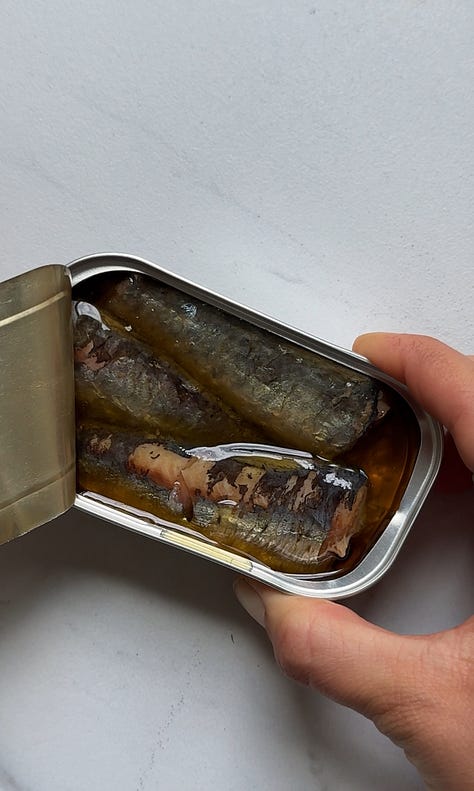
2. People freak out about “color added” in salmon, but is it really that bad?
In short, my opinion is yes - but it might not be why you think.
First, let’s discuss why they are adding color in the first place. Wild salmon naturally gets its pinkish-orange color from astaxanthin, a carotenoid pigment found in their natural diet, like shrimp, krill, and other small fish). This pigment is a powerful antioxidant and gives wild salmon its vibrant color. On the other hand, farmed salmon has a different diet (mostly consisting of fishmeal and synthetic feed), which lacks the same natural sources of astaxanthin and therefore farmed salmon can be a duller, paler color—closer to gray. To remedy this, fish farmers sometimes add pigments in the form of synthetic astaxanthin to the feed.
My issue isn’t so much with the actual color added (although I am curious about the health ramifications of this synthetic ingredient) but more so a concern around the feed and overall diet of farmed fish. In the wild, salmon eat a natural diet that provides them with astaxanthin, but farmed fish often rely on fishmeal and plant-based feed, which isn’t as rich in carotenoids. I really believe that it is important that animals are fed their natural diets, and that is not the case with farmed fish that require added color. I would recommend sourcing farmed fish from a quality source that practices regenerative aquaculture.
3. What’s the deal with mercury? How often/how much can I eat high mercury fish like tuna?
See above for the section on mercury! I do think it is a good idea to be aware of the mercury levels in certain fish and limit them as needed. I probably wouldn’t recommend eating a can of tuna everyday. However, my research has led me to believe that the nutrient-density of seafood and the health benefits far outweigh the concern for mercury in most cases.
Also, it is important to note that fish also contains the mineral selenium. Selenium may protect against mercury toxicity by binding to methylmercury and reducing its toxicity. This is another interesting example of nature having it all figured out - it has set up this system where while fish do accumulate toxic heavy metals, but they are also a great source of a nutrient that can mitigate the impacts. If you’re worried about mercury, stick to the smaller fish or source from a brand like Seatopia that tests.
4. Microplastic pollutants in ocean effects on seafood?
Unfortunately, microplastics contamination is so widespread that it is pretty much impossible to avoid entirely. Because of widespread contamination, marine life like fish and shellfish do ingest microplastics and while there is limited research surrounding microplastics, there is concern regarding toxicity. My primary suggestion would be to limit exposure to microplastics as much as possible - avoid plastic water bottles and plastic packaged foods, use an air filter, use glass food storage rather than plastic, buy natural fiber clothing rather than synthetic materials, use wooden cutting boards over plastic.
For me, diligently avoiding plastics in my life, the nutritional benefits of seafood, combined with sourcing quality seafood makes me feel comfortable consuming seafood. If you are concerned about microplastics in fish, source from a quality fish farm like Seatopia and consider avoiding shellfish.
5. Are you concerned about parasites in salmon?
I buy my seafood from reliable sources and follow food safety regulations, therefore I am not concerned. Avoid poor quality farmed fish.
6. How do you feel about sushi/poke in terms of sourcing/quality?
This really depends on where you are shopping or dining. The best option would probably be to make it at home using a quality wild-caught fish from a trusted source or buying a quality farmed fish. If you are concerned, ask about the store or restaurant’s freezing process - I would hope and expect they are following food safety regulations!



7. Affordable fish options/preparations (besides sardines) to make at home?
If you have a local seafood store or fishmonger, as them about scraps, like fish heads! They should be free or very cheap and you can make an amazing, nutritious broth
Try fish collars! They are usually more affordable, delicious and easy to cook, and they are packed with healthy fat - I love a salmon or mackerel collar.
Try other varieties of canned seafood, like oysters, octopus, mackerel, trout.
Shrimp are a great source of lean protein - you only need about 3oz for 20g of protein
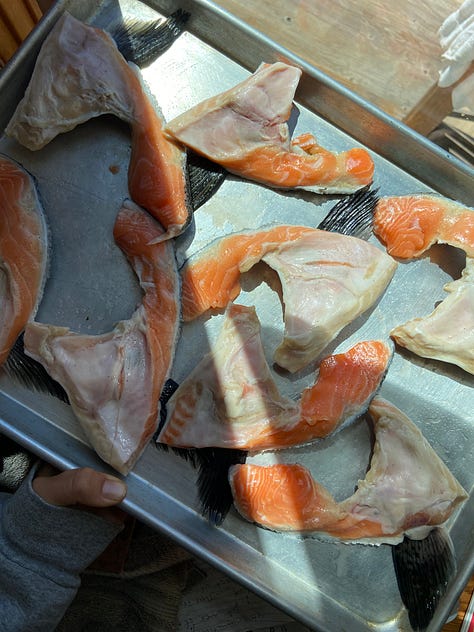

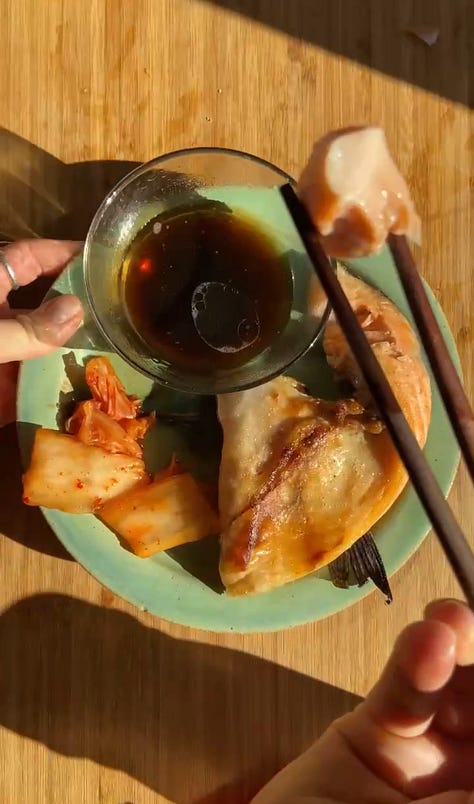
Conclusion
At the end of the day, you can find a reason to avoid almost any food (just hop onto Instagram or TikTok—plenty of people are doing that for you! 😂). After doing my own research, I've concluded that the benefits of including seafood in my diet far outweigh any potential risks.
You know what's scarier than mercury or microplastics in seafood? Not getting enough DHA to support my cognitive health as I age, the risk of cognitive decline, or not providing the essential nutrients needed for a healthy pregnancy if I choose to have a baby.
Seafood is one of the best sources of DHA (while ALA from plants can convert to DHA, the process doesn't work efficiently for everyone). It's also packed with other vital nutrients like selenium, iodine, B12, and zinc—all critical for optimal health. That's why it concerns me when people offer a narrow view of seafood, only focusing on the negatives without balancing the conversation with the massive health benefits and tips for sustainable sourcing.
This post represents my personal take on the seafood debate. Of course, I encourage you to make the choices that work best for you and your family. I hope I've cleared up some confusion, provided helpful resources to support your own research, and inspired you to approach your diet and life with nuance and balance.
Now... who’s up for some sushi?! 🙃
P.S. Are there other topics that you would like me to do ‘Fear-mongering or Fact’ about? Let me know in the comments!!





As always, valuable content!
I needed this! Thank you for all the info ❤️